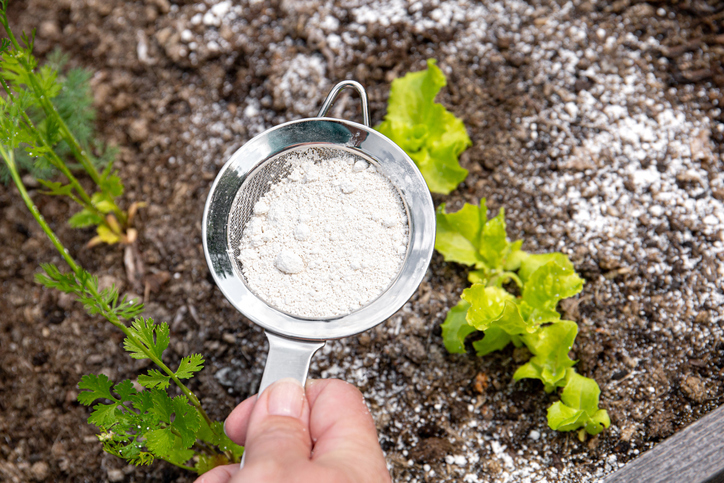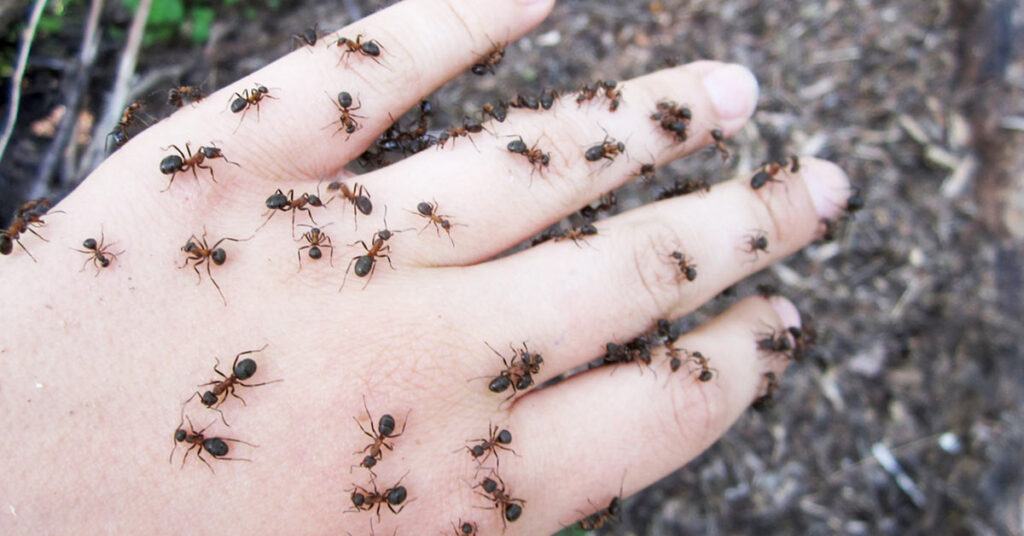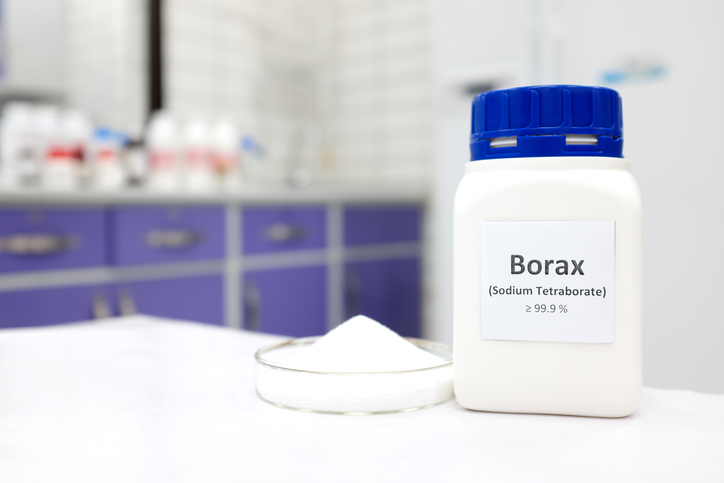Diatomaceous earth is a natural substance that can be highly effective in controlling ants. Derived from fossilized remains of diatoms, diatomaceous earth is a fine powder with microscopic sharp edges that can penetrate the exoskeleton of ants, leading to their dehydration and ultimate demise. It can be used both indoors and outdoors as a non-toxic and environmentally friendly method for ant control.

Diatomaceous earth, often abbreviated as DE, is a naturally occurring sedimentary rock that is composed of fossilized remains of diatoms, which are tiny aquatic organisms with hard shells. It is commonly used in various applications, including pest control, gardening, filtration, and industrial processes.
What Is Diatomaceous Earth Made Of?
Diatomaceous earth is primarily composed of silica, a mineral that makes up the cell walls of diatoms. These diatoms extract silica from their environment to build their shells, and over time, their accumulated remains form deposits of diatomaceous earth. The composition of diatomaceous earth can vary, but it typically consists of 80-90% silica, with traces of other minerals such as calcium, magnesium, and iron.
How Does Diatomaceous Earth Work?
Diatomaceous earth works as a mechanical insecticide rather than a chemical one. The microscopic diatoms in the earth have sharp edges and a porous structure. When insects come into contact with diatomaceous earth, the sharp edges of the diatoms pierce the insects’ exoskeletons, causing tiny cuts and abrasions. As a result, the insects lose moisture rapidly, leading to dehydration and death.
Additionally, diatomaceous earth has absorbent properties. It can effectively absorb lipids from the exoskeletons of insects, further dehydrating them. This dual action of physical abrasion and absorption contributes to its efficacy in controlling pests.
It is important to note that diatomaceous earth primarily affects insects with exoskeletons, such as ants, fleas, cockroaches, and bed bugs. It is not effective against pests like spiders, ticks, or rodents, which do not rely on an exoskeleton for protection.
Diatomaceous Earth And Ant Control
What Types Of Ants Can Be Controlled With Diatomaceous Earth?
Diatomaceous earth can be effective in controlling a wide range of ant species. It works well against common household ants such as pavement ants, odorous house ants, Argentine ants, and pharaoh ants. Additionally, diatomaceous earth can also be used to control other ant species like carpenter ants, fire ants, and even invasive species.
Fire Ants
Diatomaceous earth can provide some level of control against fire ants, but it may not be as effective as other methods specifically designed for fire ant control. Fire ant colonies have large populations, aggressive behavior, and multiple queens, making them more resilient. While diatomaceous earth can help reduce fire ant numbers, it may not eliminate the entire colony. For effective fire ant control, it is recommended to combine multiple approaches, including targeted baits and insecticides specifically formulated for fire ants.
Carpenter Ants
While diatomaceous earth can be used for controlling carpenter ants, its effectiveness may vary. Carpenter ants are known to have large colonies and satellite nests, which can make them more challenging to eliminate entirely. Diatomaceous earth may help control the worker ants, but it may not be as effective in reaching the hidden nests or eliminating the carpenter ant queens. For severe carpenter ant infestations, it is advisable to seek professional assistance to ensure effective control.
Ant Queens
Diatomaceous earth has the potential to kill ant queens, but it may take longer compared to worker ants. The primary goal of using diatomaceous earth is to disrupt the ant colony’s functioning by targeting the workers, who are responsible for foraging and maintaining the colony. By eliminating the workers, the colony’s food supply and overall stability are compromised, which can eventually lead to the death of the queen. However, it is essential to note that ant colonies can have multiple queens, and complete eradication may require continued application of diatomaceous earth over time.
How To Use Diatomaceous Earth For Ant Control?
Diatomaceous earth is a natural sedimentary rock made up of fossilized remains of diatoms. These diatoms are microscopic algae that have hard shells composed of silica. DE is primarily composed of silica, but it may also contain trace amounts of other minerals. When using DE for pest control, it is essential to choose food-grade DE, which has been processed and purified to remove impurities and contaminants. The unique physical properties of DE, including its sharp edges and porous structure, make it an effective tool for pest control. When insects come into contact with DE, its abrasive nature damages their exoskeletons, leading to dehydration and eventually death. DE can be used against various pests, including ants, by applying a thin layer of powder in areas of ant activity.
The Effective Range Of Diatomaceous Earth Against Ants
Diatomaceous earth has a limited effective range against ants. Since it works through physical abrasion and absorption, ants must come into direct contact with the diatomaceous earth powder for it to be effective. The powder’s sharp edges must puncture the ants’ exoskeletons to cause damage and dehydration. Therefore, it is crucial to apply the diatomaceous earth directly in the areas where ants are active or along their trails to maximize its effectiveness.
How Long Does It Take For Diatomaceous Earth To Kill Ants?
The time it takes for diatomaceous earth to kill ants can vary depending on several factors. Generally, it may take anywhere from several hours to a few days for the diatomaceous earth to have a noticeable impact on ant populations. The exact timeframe depends on factors such as the size of the ant colony, the level of infestation, and the ants’ foraging behavior. It’s important to be patient and continue the application of diatomaceous earth until the ant activity significantly decreases.
Does Diatomaceous Earth Work On Other Pests Besides Ants?
Yes, diatomaceous earth can be effective against various pests besides ants. It can help control other crawling insects such as fleas, cockroaches, bed bugs, silverfish, and earwigs. The physical mode of action of diatomaceous earth works similarly on these insects, causing damage to their exoskeletons and leading to dehydration.
Using Diatomaceous Earth Indoors And Outdoors
Diatomaceous earth is a versatile solution for ant control that can be used effectively both indoors and outdoors. Whether you are dealing with ant infestations in your home, garden, or outdoor spaces, diatomaceous earth offers a natural and non-toxic approach to combatting ants. By understanding how to properly apply diatomaceous earth in different settings, you can create barriers, deter ants, and target ant mounds for effective control.
How To Apply Diatomaceous Earth In Gardens For Ant Infestations?
When it comes to ant infestations in gardens, diatomaceous earth can be a valuable tool for control. To effectively use diatomaceous earth in gardens, start by identifying the ant trails and locating the ant mounds or nests.
Once identified, apply a thin layer of diatomaceous earth around the ant mounds, focusing on areas where ants are most active. It’s important to reapply the diatomaceous earth after rain or heavy watering as moisture can reduce its effectiveness. Regularly monitor ant activity and reapply as necessary. Consider using a duster or handheld sprayer to apply the diatomaceous earth more evenly and reach difficult-to-access areas in your garden. By using diatomaceous earth in your garden, you can target ant infestations and help protect your plants from the damaging effects of ants.
Can Diatomaceous Earth Deter Ants From Entering My Home?
Yes, diatomaceous earth can act as a deterrent to prevent ants from entering your home. By applying a barrier of diatomaceous earth around entry points such as windowsills, doorways, and cracks, you create an obstacle that ants are reluctant to cross. The sharp edges of the diatomaceous earth particles will physically damage the ants’ exoskeletons, causing them to avoid those areas.
Can I Use Diatomaceous Earth In My Kitchen For Ants?
Yes, diatomaceous earth can be used in the kitchen for ant control. However, it is important to ensure that the diatomaceous earth is applied in areas where it will not come into direct contact with food preparation surfaces or utensils. Focus on applying it along baseboards, under appliances, and in corners where ants are commonly found. Take precautions to avoid contaminating food or food storage areas with the diatomaceous earth.
Safety And Environmental Considerations
Is Diatomaceous Earth Safe For Humans And Pets?
Diatomaceous earth is generally considered safe for humans and pets when used properly. However, it is crucial to choose food-grade diatomaceous earth and follow the recommended safety precautions. Avoid inhaling the dust as it can cause respiratory irritation, especially for individuals with pre-existing respiratory conditions. When applying diatomaceous earth, use protective gear such as a dust mask and gloves to minimize contact with the skin.
Are There Any Health Risks Associated With Using Diatomaceous Earth?
While diatomaceous earth is generally safe, it can cause skin dryness or irritation if it comes into direct contact with the skin. Some individuals may also experience minor eye or respiratory irritation when exposed to the dust. To minimize potential health risks, it is advisable to handle diatomaceous earth in a well-ventilated area and avoid prolonged exposure. If any adverse reactions occur, discontinue use and seek medical advice.
How Does Diatomaceous Earth Affect The Environment?
Diatomaceous earth is an environmentally friendly option for pest control as it is derived from natural sources. It does not persist in the environment or contribute to long-term pollution. However, it is important to note that diatomaceous earth can affect non-target insects, including beneficial ones like bees and ladybugs if they come into contact with the powder. Therefore, it is recommended to apply diatomaceous earth selectively and avoid areas where beneficial insects are active.
Furthermore, it is crucial to prevent excessive runoff of diatomaceous earth into water bodies, as it can harm aquatic life. Avoid applying it near storm drains or in areas where it may wash into water sources. Follow the instructions provided by the manufacturer for proper disposal of unused diatomaceous earth to minimize any potential environmental impact.
Buying And Applying Diatomaceous Earth
Where Can I Buy Diatomaceous Earth?
Diatomaceous earth can be purchased from various retailers. It is commonly available at garden centers, agricultural supply stores, and online platforms like Amazon and eBay. Additionally, home improvement stores such as Home Depot and Lowe’s often carry diatomaceous earth products. When purchasing, ensure that you choose food-grade diatomaceous earth for safe and effective use.
Can Diatomaceous Earth Be Mixed With Other Substances For Ant Control?
Yes, diatomaceous earth can be mixed with other substances to enhance its effectiveness for ant control. One common method is to combine diatomaceous earth with a food attractant, such as sugar or honey, to entice ants to come into contact with the powder. This bait can be placed in areas of ant activity to attract and kill the ants. It is important to note that adding other substances to diatomaceous earth may alter its physical properties and affect its efficacy, so it is recommended to follow established recipes or guidelines when creating DIY ant baits.
How Often Should You Reapply Diatomaceous Earth For Ant Control?
The frequency of diatomaceous earth reapplication depends on several factors, including the severity of the ant infestation and environmental conditions. In dry conditions, diatomaceous earth can remain effective for several weeks or even months. However, if there is significant rainfall or if the treated area becomes wet, it is advisable to reapply the diatomaceous earth to maintain its potency. Regularly monitor ant activity and reapply as necessary to ensure consistent ant control.
Does Diatomaceous Earth Lose Its Effectiveness When Wet?
Yes, diatomaceous earth loses its effectiveness when it gets wet. Moisture can render diatomaceous earth less abrasive and reduce its ability to damage the exoskeleton of insects, including ants. Therefore, it is important to apply diatomaceous earth in dry conditions and reapply after rainfall or heavy watering. If the area where you applied diatomaceous earth becomes wet, it is advisable to wait for it to dry before reapplying to ensure its efficacy in ant control.
Aftercare And Alternatives
How To Clean Up Diatomaceous Earth After Application?
Cleaning up diatomaceous earth after its application is a relatively simple process. Since diatomaceous earth is a fine powder, it can easily be swept or vacuumed up. Use a broom or brush to sweep the diatomaceous earth into a dustpan, or use a vacuum cleaner with a HEPA filter to collect the powder. Be thorough in your cleaning to ensure all traces of diatomaceous earth are removed from surfaces, especially if you have pets or young children who may come into contact with the area. Dispose of the collected diatomaceous earth in a sealed plastic bag and discard it in an outdoor trash bin.
What Are The Alternatives To Diatomaceous Earth For Ant Control?
While diatomaceous earth is an effective and popular choice for ant control, there are alternative methods you can consider. When considering alternatives to diatomaceous earth, it is important to assess their safety, effectiveness, and compatibility with your specific circumstances. Choose a method that aligns with your preferences and requirements for ant control:
Natural Repellents
There are various natural repellents that can deter ants from entering your home. These include essential oils like peppermint, cinnamon, or citrus oils, which can be applied near entry points or along ant trails. Ants dislike the strong scent of these oils and are likely to avoid them.
Vinegar
Vinegar is another natural deterrent that can be used to control ants. Mix equal parts of vinegar and water in a spray bottle and apply it to areas where ants are present or may gain entry. The strong smell of vinegar disrupts their scent trails and makes your home less appealing to them.
Boric Acid
Similar to diatomaceous earth, boric acid is a white powder that can be used as bait to eliminate ants. Mix boric acid with a sweet substance like sugar or honey to attract ants. They will consume the bait and carry it back to their colony, effectively killing the entire ant population.
Commercial Ant Baits
There are various commercially available ant baits that come in gel or liquid form. These baits contain ant attractants combined with insecticides that target ants. Follow the instructions provided by the manufacturer for proper usage.
Conclusion
Diatomaceous earth is a natural and effective solution for ant control. It is a powdery substance made of fossilized remains of diatoms, which have sharp edges that damage the exoskeleton of ants and cause dehydration. Diatomaceous earth can be used both indoors and outdoors to control various ant species, and it provides long-lasting results when applied properly. By understanding how to use diatomaceous earth effectively and considering safety precautions, you can harness its power to eliminate ants and create an ant-free environment in your home or garden.




